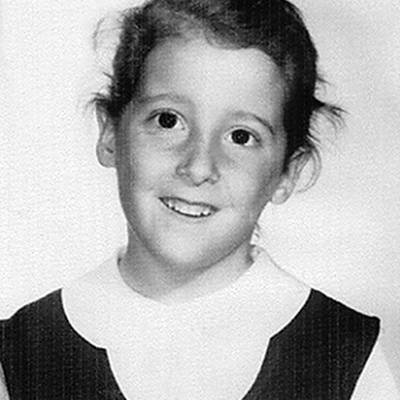Mary Patten is a visual artist, video-maker, writer, educator, and long-time political activist, with life-long commitments to social movements for racial justice, against the carceral state, to fight the AIDS epidemic, and for queer and LGBTQ liberation. For years, Patten has led or participated in many public collaborations – murals, billboards, and large scale interdisciplinary projects – including Chicago Torture Justice Memorials (CTJM), Feel Tank Chicago, ACT UP Chicago, Artists’ Call Against Intervention in Central America and the Caribbean, Cityarts Workshop, and the Madame Binh Graphics Collective – to reclaim a “utopia of the everyday,” a way of being together in the world that allows for anger, joy, and reparative visions.
Patten began as a painter, then moved to murals, graphics, and printmaking. In 1983, Patten moved from NYC to Chicago, worked alongside a loose community of anarcho-surrealist artists called Axe St. Arena, and together with other queers founded ACT UP Chicago – an organizing, advocacy, and cultural project working to end the AIDS crisis, fusing politics with desire, creative activism, and survival.
Patten has exhibited extensively in Chicago and Illinois, across the U.S., and internationally for over 45 years – in alternative spaces, university museums, international film and video festivals, queer venues, and spaces that support experimental and politically-charged work. Patten’s exhibition history includes the Brooklyn Museum, Contemporary Art Museum Houston, Tufts University Art Galleries, Cooper Union, Schomburg Center for Research in Black Culture, threewalls, Interference Archive, New Museum of Contemporary Art (NYC), VOX Populi, Shedhalle in Zürich, Chicago Cultural Center, Randolph Street Gallery, Creative Time (with Feel Tank Chicago), and Kunstverein und Kunsthaus Hamburg. Patten’s videos have been screened at the Gene Siskel Film Center, Rotterdam International Film Festival, Visual AIDS, Artists Space, the London LGBTIQ+ Film Festival, the Hong Kong Lesbian and Gay Film Festival, and MIX NYC, among many others.
Patten’s writing includes the book Revolution as an Eternal Dream: the exemplary failure of the Madame Binh Graphics Collective, and visual / text essays for “Art AIDS America,” The Passionate Camera, Radical Teacher, WhiteWalls, and, with Feel Tank Chicago, Re/Imagining Depression: Creative Approaches to “Feeling Bad”. With Chicago Torture Justice Memorials, Patten has received a Robert Rauschenberg “Artist As Activist” Fellowship and an Art for Justice Fellowship, as well as individual awards from Artadia, the Illinois Arts Council, 3Arts, and the National Endowment for the Arts. After years as a full-time professor, Patten teaches part-time in the Film, Video, New Media, and Animation Department at the School of the Art Institute of Chicago.
Featured Artworks
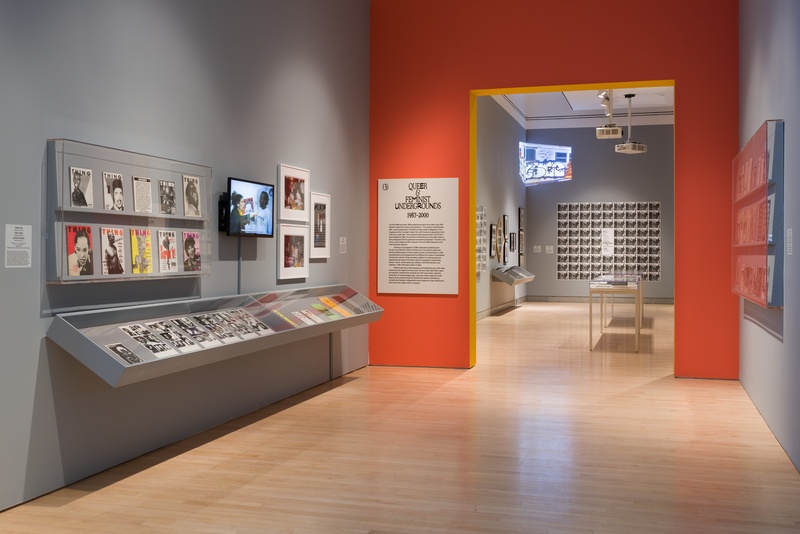 Hokey Sapp Does SPEW + THING magazine installation at "Copy Machine Manifestos"
Photo courtesy of the Brooklyn Museum and Paula Abreu Pita.
17 min. single-channel video with editions of THING magazine, photos, and related ephemera at “Copy Machine Manifestos: Artists Who Make Zines,” Brooklyn Museum, 2023-4.
Hokey Sapp Does SPEW + THING magazine installation at "Copy Machine Manifestos"
Photo courtesy of the Brooklyn Museum and Paula Abreu Pita.
17 min. single-channel video with editions of THING magazine, photos, and related ephemera at “Copy Machine Manifestos: Artists Who Make Zines,” Brooklyn Museum, 2023-4.
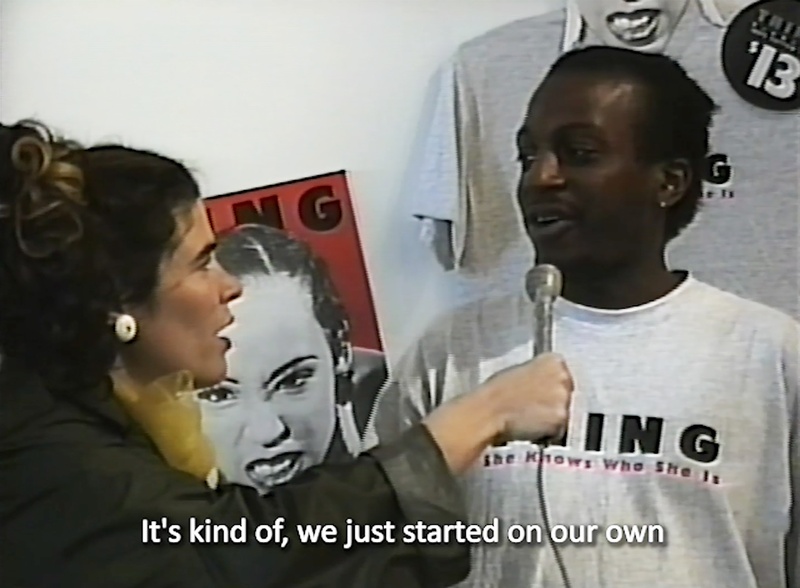 Hokey Sapp Does SPEW (video still)
photo by Mary Patten
Hokey Sapp does SPEW features Kate Schechter performing her invented media personality Hokey Sapp (a queered-up amalgam of former NPR radio hosts Cokey Roberts and Mara Tapp) interviewing some of the luminaries in attendance at SPEW: The Homographic Convergence, a queer zine convention hosted by Randolph Street Gallery in Chicago in May, 1991. SPEW brought together artists, writers, editors of zines, performers, video-makers, activists, and bands from throughout the US and Canada, and marked the explosion of queercore subcultures through unabashed fashion, outrageous politics, humor, and joy. We asked participants about their thoughts and feelings on the meaning of “queer” as manifest in this zine subculture, in queer theory, and in the intense activism of both ACT UP and Queer Nation. The raw VHS footage, shot in 1991, was edited 31 years later, in 2022. Mary Patten: director, videographer, and editor; Kate Schechter, interviewer.
Hokey Sapp Does SPEW (video still)
photo by Mary Patten
Hokey Sapp does SPEW features Kate Schechter performing her invented media personality Hokey Sapp (a queered-up amalgam of former NPR radio hosts Cokey Roberts and Mara Tapp) interviewing some of the luminaries in attendance at SPEW: The Homographic Convergence, a queer zine convention hosted by Randolph Street Gallery in Chicago in May, 1991. SPEW brought together artists, writers, editors of zines, performers, video-makers, activists, and bands from throughout the US and Canada, and marked the explosion of queercore subcultures through unabashed fashion, outrageous politics, humor, and joy. We asked participants about their thoughts and feelings on the meaning of “queer” as manifest in this zine subculture, in queer theory, and in the intense activism of both ACT UP and Queer Nation. The raw VHS footage, shot in 1991, was edited 31 years later, in 2022. Mary Patten: director, videographer, and editor; Kate Schechter, interviewer.
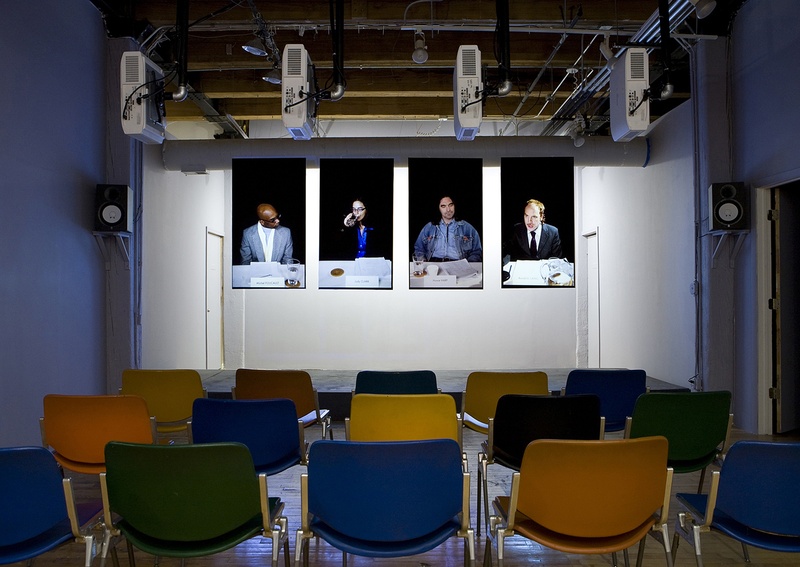 PANEL, 4-channel video installation
photo by Gita Jackson
PANEL is based on a transcript of a discussion on prisons and asylums at the historic “Schizo Culture” conference at Columbia University in 1975. The original panel featured philosopher Michel Foucault, radical psychiatrist R. D. Laing, Insane Liberation Front activist Howie Harp, and radical prisoners’ advocate Judith Clark. The piece has manifested as a multimedia installation, two series of silkscreened prints, live performances, and a one-channel video. The first version of PANEL includes four performance-based video channels, four “life-size” prints – each corresponding to and mirroring one of the video channels – an array of chairs, a large wall drawing, and text. Each vertical video panel / projection is a separate, synched channel of HD video and audio. All words are taken directly from the transcript, but i made no attempt to cast characters based on “realistic” representation. The exhibition also featured a live staging of the event, and a marathon performance reading of texts by poets, activists, artists, and theorists who attended Schizo Culture, or who were active in NYC in the 1970s.
PANEL, 4-channel video installation
photo by Gita Jackson
PANEL is based on a transcript of a discussion on prisons and asylums at the historic “Schizo Culture” conference at Columbia University in 1975. The original panel featured philosopher Michel Foucault, radical psychiatrist R. D. Laing, Insane Liberation Front activist Howie Harp, and radical prisoners’ advocate Judith Clark. The piece has manifested as a multimedia installation, two series of silkscreened prints, live performances, and a one-channel video. The first version of PANEL includes four performance-based video channels, four “life-size” prints – each corresponding to and mirroring one of the video channels – an array of chairs, a large wall drawing, and text. Each vertical video panel / projection is a separate, synched channel of HD video and audio. All words are taken directly from the transcript, but i made no attempt to cast characters based on “realistic” representation. The exhibition also featured a live staging of the event, and a marathon performance reading of texts by poets, activists, artists, and theorists who attended Schizo Culture, or who were active in NYC in the 1970s.
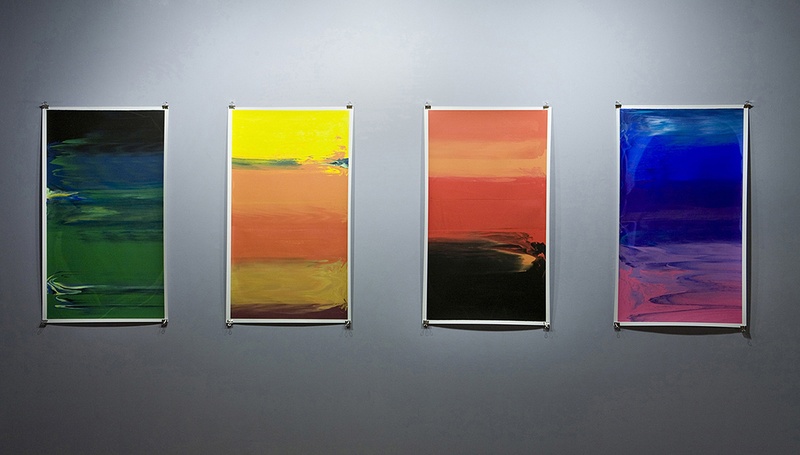 PANEL – installation view of “The Mirror Selves"
photo by Gita Jackson
Four large abstract silkscreen prints, each corresponding to and mirroring one of the 4 video channels opposite, embody the colors of each panelist’s imagined “aura”: blue, magenta and pink for Foucault; red and black for Judy; yellow ochre and orange for Harp; acid bluish-greens for Laing.
PANEL – installation view of “The Mirror Selves"
photo by Gita Jackson
Four large abstract silkscreen prints, each corresponding to and mirroring one of the 4 video channels opposite, embody the colors of each panelist’s imagined “aura”: blue, magenta and pink for Foucault; red and black for Judy; yellow ochre and orange for Harp; acid bluish-greens for Laing.
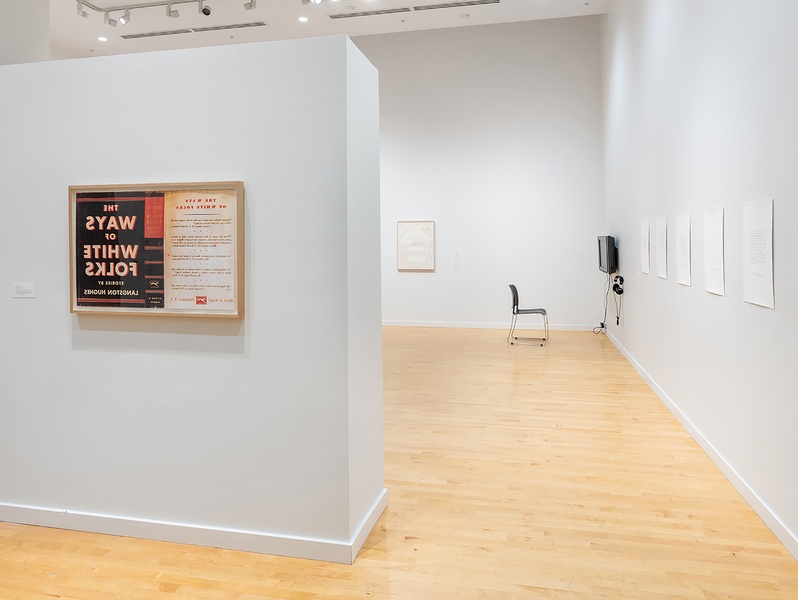 Black Books and the Ways of White Folks, installation view
photo by Mario Gallucci Studio
The work was commissioned by Daniel Tucker for “Organize Your Own (OYO): the Politics and Poetics of Self-Determination Movements.” OYO drew me back to my own library, to texts that changed the way i saw the world, and my place in it – especially passages that articulate and evoke different ways of whiteness in stark relief against the blackness of being in America.
Black Books and the Ways of White Folks, installation view
photo by Mario Gallucci Studio
The work was commissioned by Daniel Tucker for “Organize Your Own (OYO): the Politics and Poetics of Self-Determination Movements.” OYO drew me back to my own library, to texts that changed the way i saw the world, and my place in it – especially passages that articulate and evoke different ways of whiteness in stark relief against the blackness of being in America.
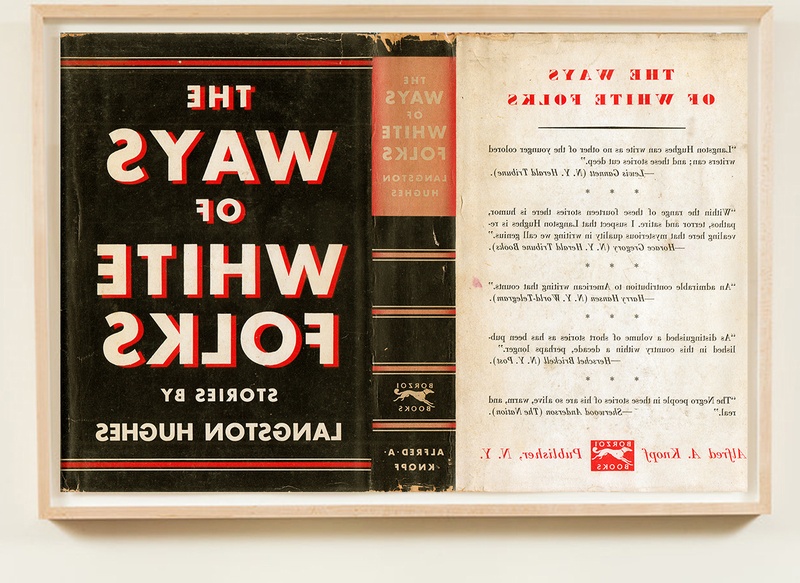 The Ways of White Folks (detail view)
Framed 4-color process silkscreened print based on a dust jacket from the 1963 edition of Langston Hughes’ The Ways of White Folks, originally published in 1934. The print is “flipped” so that the title / text reads backwards, a kind of mirror image.
The Ways of White Folks (detail view)
Framed 4-color process silkscreened print based on a dust jacket from the 1963 edition of Langston Hughes’ The Ways of White Folks, originally published in 1934. The print is “flipped” so that the title / text reads backwards, a kind of mirror image.
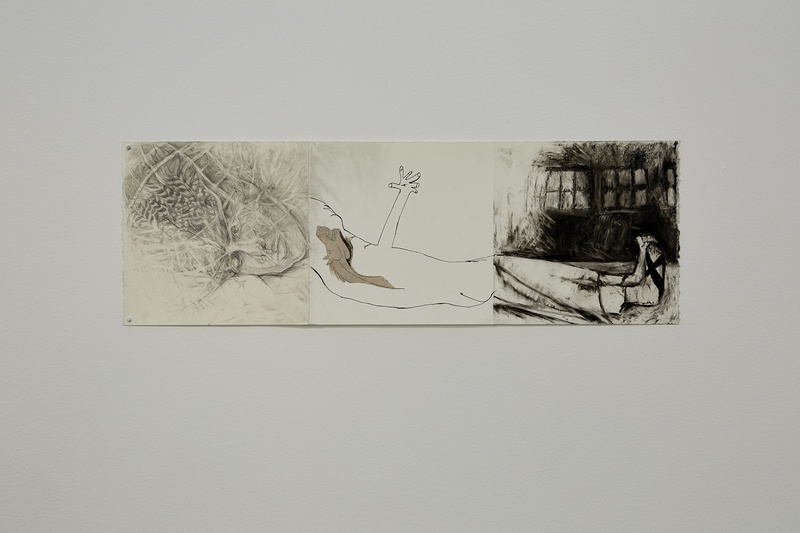 The Exquisite Corpse of Nidal Malik Hasan
photo by Mary Patten
In spring 2014, artists Aaron Hughes and Jeanne Dunning organized “Surrealism and War” for the National Veterans Art Museum, and invited a group of artists to initiate the making of an exquisite corpse, based on a veteran of our choosing. I chose Nidal Malik Hasan, the army major specializing in preventive and disaster psychiatry who killed 13 people (mostly fellow soldiers) and wounded many others in Fort Hood, Texas in November, 2009. The terrible paradoxes that riddle Hasan’s story parallel the bigger schizo-narrative of the U.S. wars in Iraq and Afghanistan. In the surrealist tradition, each initiating artist chose another artist to draw the body. i chose Elise Gardella, who then passed the corpse on to a third artist, Julia Shirar, who contributed legs and feet.
The Exquisite Corpse of Nidal Malik Hasan
photo by Mary Patten
In spring 2014, artists Aaron Hughes and Jeanne Dunning organized “Surrealism and War” for the National Veterans Art Museum, and invited a group of artists to initiate the making of an exquisite corpse, based on a veteran of our choosing. I chose Nidal Malik Hasan, the army major specializing in preventive and disaster psychiatry who killed 13 people (mostly fellow soldiers) and wounded many others in Fort Hood, Texas in November, 2009. The terrible paradoxes that riddle Hasan’s story parallel the bigger schizo-narrative of the U.S. wars in Iraq and Afghanistan. In the surrealist tradition, each initiating artist chose another artist to draw the body. i chose Elise Gardella, who then passed the corpse on to a third artist, Julia Shirar, who contributed legs and feet.
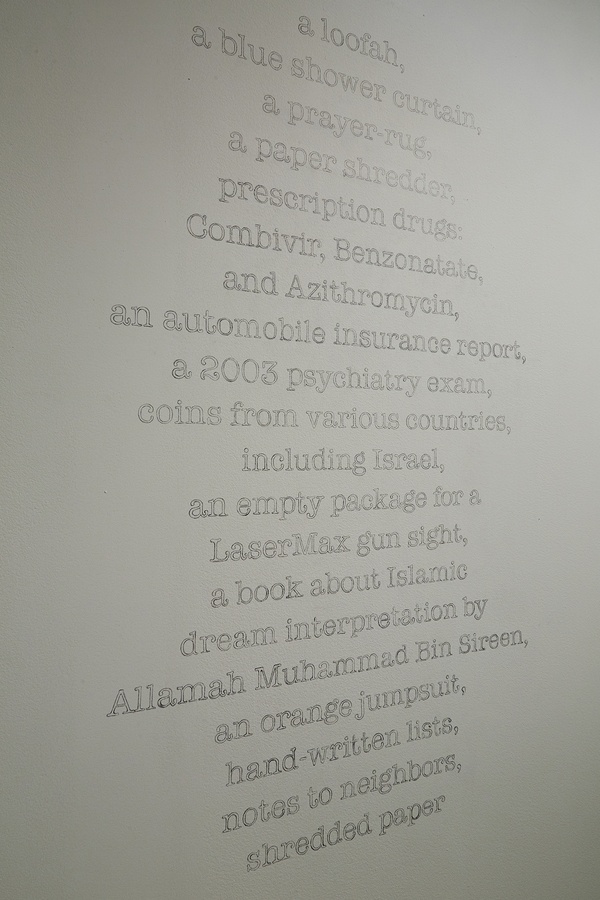 The Exquisite Corpse of Nidal Malik Hasan, installation view: graphite wall drawing
photo by Mary Patten
The large wall drawing is a list composed of phrases taken from multiple journalistic / news accounts of the events surrounding the shootings and their aftermath, and a list of objects later found in Hasan’s apartment. Together they create a kind of strange, speculative portrait of Hasan, combining traces of ordinary life and dull routine with flickers of imagined “insight” into the mind and motives of the person who carried out these mass shootings.
The Exquisite Corpse of Nidal Malik Hasan, installation view: graphite wall drawing
photo by Mary Patten
The large wall drawing is a list composed of phrases taken from multiple journalistic / news accounts of the events surrounding the shootings and their aftermath, and a list of objects later found in Hasan’s apartment. Together they create a kind of strange, speculative portrait of Hasan, combining traces of ordinary life and dull routine with flickers of imagined “insight” into the mind and motives of the person who carried out these mass shootings.
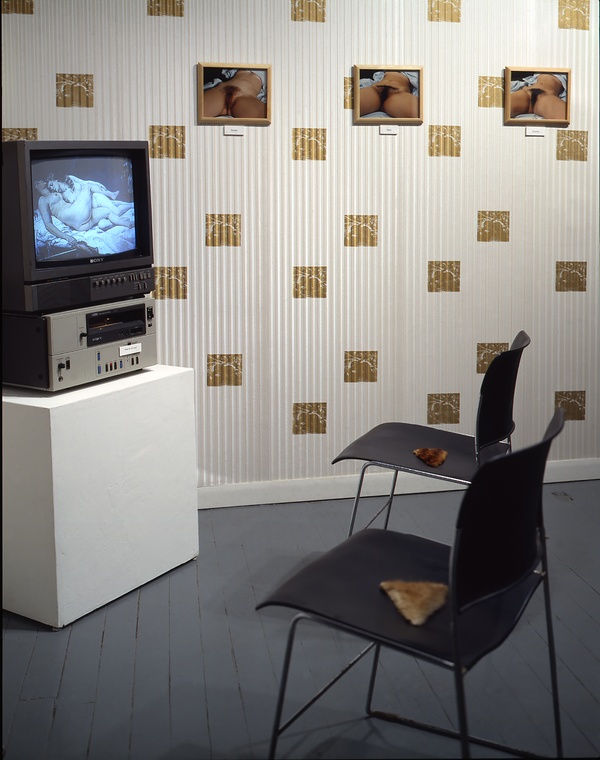 My Courbet (or, a Beaver’s Tale), installation view
Both a multimedia installation and a single-channel videotape, My Courbet... or, a beaver’s tale began with a visual referent to Courbet’s “L’Origine du Monde/The Origin of the World.” Color photographs of women posed in the manner of the painting, named “Louise,” “Inez,” etc., were hung on silk-screened “beaver” wallpaper. Viewers were invited to sit and view a video “art history lecture” purporting to reveal a “true history/or rather herstory” of lesbians in art. Glued to the seats of the chairs were triangles of fur – simulations of “beavers,” “twats,” or “cunts.” The video voice-over is laced with lies, half-truths, sexual innuendo, jokes, and art-historical clichés, forming a narrative through 100+ examples of historical and contemporary art works, pornography, photography, and agit-prop.
My Courbet (or, a Beaver’s Tale), installation view
Both a multimedia installation and a single-channel videotape, My Courbet... or, a beaver’s tale began with a visual referent to Courbet’s “L’Origine du Monde/The Origin of the World.” Color photographs of women posed in the manner of the painting, named “Louise,” “Inez,” etc., were hung on silk-screened “beaver” wallpaper. Viewers were invited to sit and view a video “art history lecture” purporting to reveal a “true history/or rather herstory” of lesbians in art. Glued to the seats of the chairs were triangles of fur – simulations of “beavers,” “twats,” or “cunts.” The video voice-over is laced with lies, half-truths, sexual innuendo, jokes, and art-historical clichés, forming a narrative through 100+ examples of historical and contemporary art works, pornography, photography, and agit-prop.
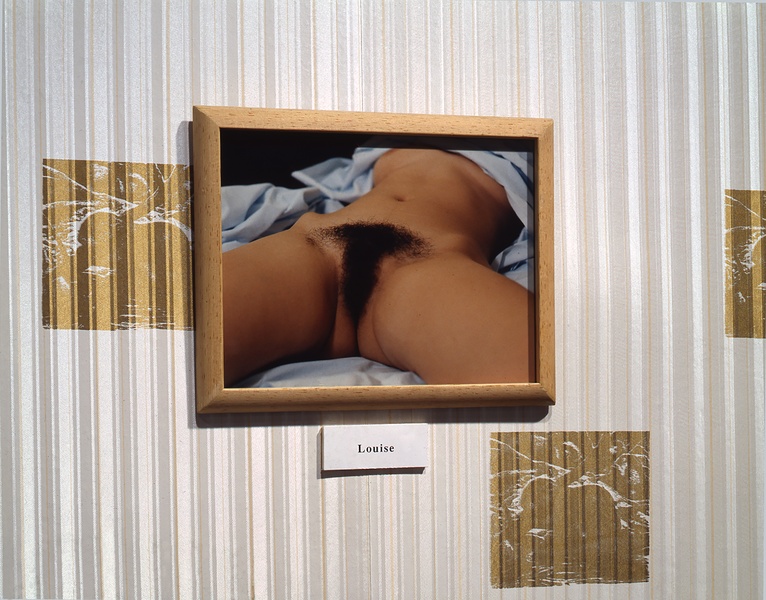 My Courbet (or, a Beaver’s Tale), detail
framed color photograph of “Louise,” of a woman’s body posed in the manner of Courbet’s famous painting. The photograph is hung on silkscreened wallpaper with a repeating pattern of a golden beaver.
My Courbet (or, a Beaver’s Tale), detail
framed color photograph of “Louise,” of a woman’s body posed in the manner of Courbet’s famous painting. The photograph is hung on silkscreened wallpaper with a repeating pattern of a golden beaver.
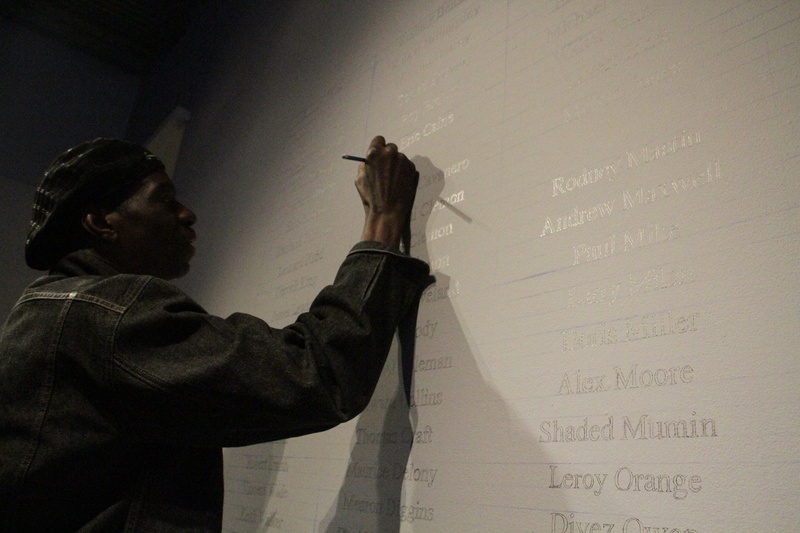 Darrell Cannon signing the Wall of Names at "Opening the Black Box: The Charge is Torture"
photo by Gonzalo Escobar
Since 2011, i have been working with Chicago Torture Justice Memorials, a cultural collective that came together to support survivors of police torture and ask, “What would justice look like in these cases?” CTJM was central to the campaign that won reparations for survivors from the city of Chicago in 2015. At our first exhibition, "Opening the Black Box: The Charge is Torture" in 2012, CTJM created a wall of names of torture survivors. Each name was carefully and painstakingly drawn with carbon pencil on blue chalk lines. We left spaces blank for survivors to write their names in what became a public ritual, testimony that they are authors of their own lives. This slide is of torture survivor Darrell Cannon signing his name. CTJM conceived of the installation of which this was a part, and i designed the wall, the grid of names, the selection of materials, color, and led the drawing process.
Darrell Cannon signing the Wall of Names at "Opening the Black Box: The Charge is Torture"
photo by Gonzalo Escobar
Since 2011, i have been working with Chicago Torture Justice Memorials, a cultural collective that came together to support survivors of police torture and ask, “What would justice look like in these cases?” CTJM was central to the campaign that won reparations for survivors from the city of Chicago in 2015. At our first exhibition, "Opening the Black Box: The Charge is Torture" in 2012, CTJM created a wall of names of torture survivors. Each name was carefully and painstakingly drawn with carbon pencil on blue chalk lines. We left spaces blank for survivors to write their names in what became a public ritual, testimony that they are authors of their own lives. This slide is of torture survivor Darrell Cannon signing his name. CTJM conceived of the installation of which this was a part, and i designed the wall, the grid of names, the selection of materials, color, and led the drawing process.
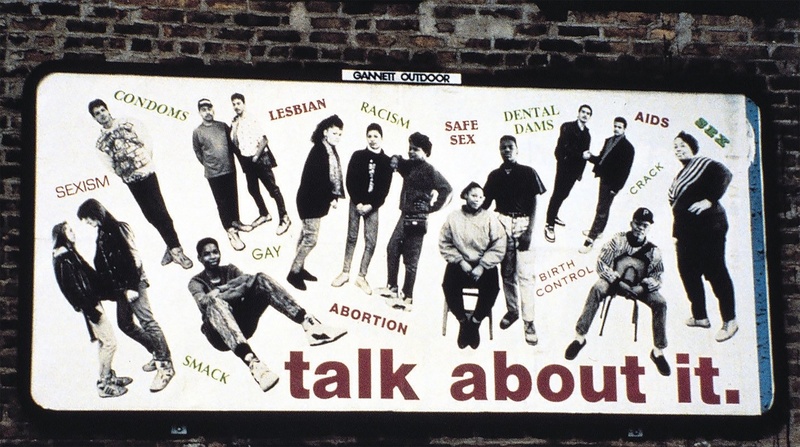 talk about it
offset litho print billboard, 5.5’ x 13,’ 1990. Commissioned by Group Material and Randolph Street Gallery for the public art project YOUR MESSAGE HERE, a series of billboards displayed throughout Chicago. Collaboration with the ACT UP Chicago’s Women’s Caucus – Mary Patten, co-creator and designer.
talk about it
offset litho print billboard, 5.5’ x 13,’ 1990. Commissioned by Group Material and Randolph Street Gallery for the public art project YOUR MESSAGE HERE, a series of billboards displayed throughout Chicago. Collaboration with the ACT UP Chicago’s Women’s Caucus – Mary Patten, co-creator and designer.
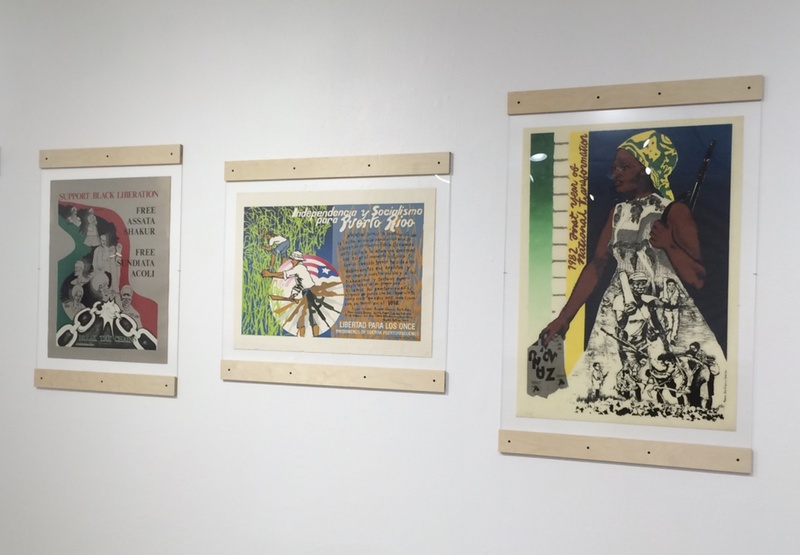 Three prints by the Madame Binh Graphics Collective at "WE DISSENT..." Cooper Union, 2018
The exhibition “WE DISSENT…” at Cooper Union presented a large range of printed material, artifacts, and ephemera created by women artists and designers at the intersection of feminism and social movements, from the 1860s to today. The exhibition included silkscreened prints, graphics, and ephemera from the Madame Binh Graphics Collective, a women’s anti-imperialist art collective active primarily in NYC from 1977-1983. Within a structure of collaborative authorship, we made stylistically diverse posters, prints and street art against racism, sexism, and in support of national liberation movements. We also taught classes in drawing, design and silk-screening. Left to right: “Support Black Liberation,” “Independencia y socialism para Puerto Rico,” “1982: First Year of National Transformation.”
Three prints by the Madame Binh Graphics Collective at "WE DISSENT..." Cooper Union, 2018
The exhibition “WE DISSENT…” at Cooper Union presented a large range of printed material, artifacts, and ephemera created by women artists and designers at the intersection of feminism and social movements, from the 1860s to today. The exhibition included silkscreened prints, graphics, and ephemera from the Madame Binh Graphics Collective, a women’s anti-imperialist art collective active primarily in NYC from 1977-1983. Within a structure of collaborative authorship, we made stylistically diverse posters, prints and street art against racism, sexism, and in support of national liberation movements. We also taught classes in drawing, design and silk-screening. Left to right: “Support Black Liberation,” “Independencia y socialism para Puerto Rico,” “1982: First Year of National Transformation.”
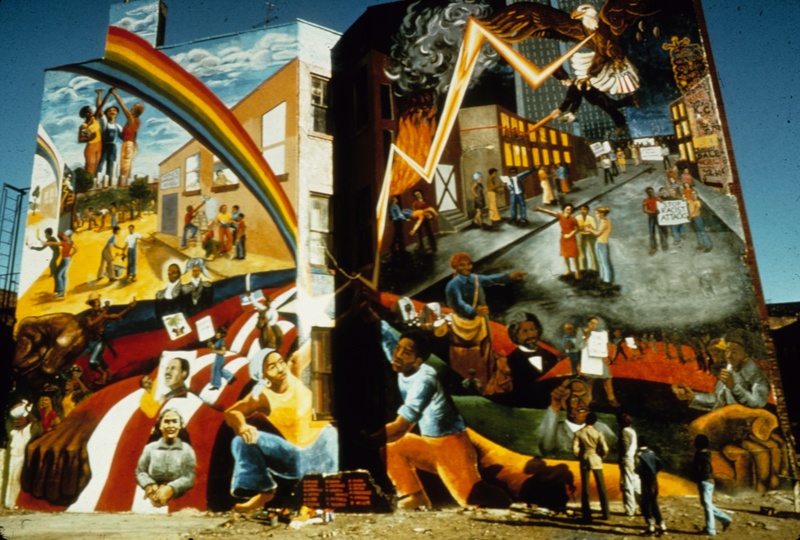 The Douglass St. Mural (Brooklyn, 1976)
Large outdoor mural of 2 views of a neighborhood – one at night, with images of fire, a march against racist attacks, and a bolt of lightning from an American eagle; the other of sunshine, a rainbow, and people playing / working together. At the base of the mural are the Black liberation, Haitian, and Puerto Rican flags, representing residents of the neighborhood, and images of iconic figures like Harriet Tubman, Lolita Lebron, and Touissaint L’Ouverture. Mural by Cityarts Workshop, Mary Patten, Project Director, 1976. The mural was destroyed when developers added a building to the adjacent empty lot.
The Douglass St. Mural (Brooklyn, 1976)
Large outdoor mural of 2 views of a neighborhood – one at night, with images of fire, a march against racist attacks, and a bolt of lightning from an American eagle; the other of sunshine, a rainbow, and people playing / working together. At the base of the mural are the Black liberation, Haitian, and Puerto Rican flags, representing residents of the neighborhood, and images of iconic figures like Harriet Tubman, Lolita Lebron, and Touissaint L’Ouverture. Mural by Cityarts Workshop, Mary Patten, Project Director, 1976. The mural was destroyed when developers added a building to the adjacent empty lot.
